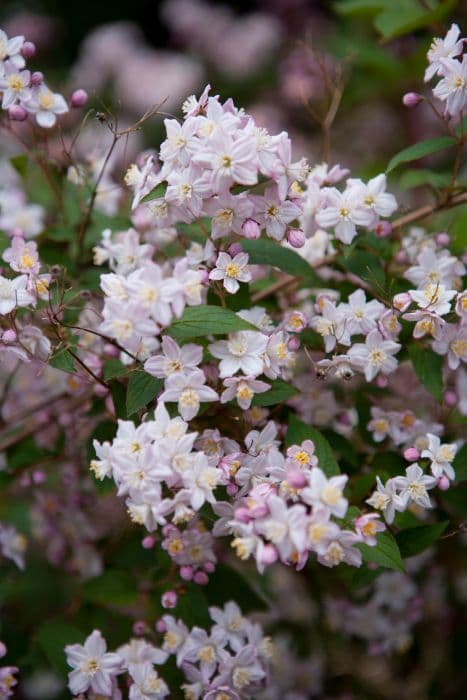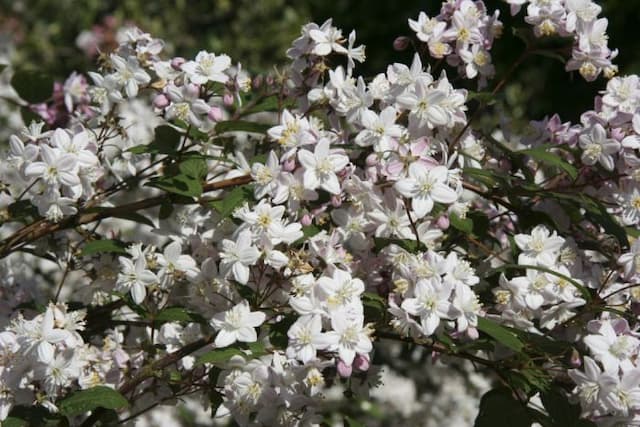Little Lime Hydrangea Hydrangea paniculata 'Jane' (PBR)

ABOUT
The Hydrangea paniculata 'Jane' is widely recognized by its common name, the 'Little Lime' hydrangea, due to its resemblance to the 'Limelight' hydrangea but in a smaller form. This cultivar is characterized by its lush green foliage and impressive, cone-shaped flower panicles. The leaves are typically dark green, which provide a beautiful backdrop to its stunning blooms. The flowers emerge a soft green color in early summer and gradually turn to shades of pink, red, and burgundy as the season progresses into fall. This captivating change in color occurs from the bottom up, giving the flowers a two-toned appearance at the peak of their transition. The flowers are quite abundant, creating a full and attractive display that can add a distinct visual interest to any garden. While the blooms are fresh, they can be cut and displayed indoors or dried for long-term arrangements. The 'Little Lime' hydrangea's ability to adapt to a range of soil types, coupled with its showy flowers that attract pollinators like bees and butterflies, make it an appealing choice for both novice and seasoned gardeners.
About this plant
 Names
NamesSynonyms
Little Lime Hydrangea, Dwarf Panicle Hydrangea.
Common names
Hydrangea paniculata 'Jane'
 Toxicity
ToxicityTo humans
The plant known as panicled hydrangea is not highly toxic to humans, but it can cause mild digestive distress if ingested. The plant contains compounds that can release cyanide when chewed or digested, leading to symptoms such as nausea, vomiting, and diarrhea. These symptoms are usually not severe, but seeking medical advice is recommended if ingestion occurs.
To pets
For pets, the panicled hydrangea is considered to be of low toxicity, but it can still cause problems if consumed. The plant contains cyanogenic glycosides, which can release cyanide in the body and may lead to symptoms like gastrointestinal upset, vomiting, and diarrhea. If a pet is suspected to have ingested parts of this plant, it is advisable to contact a veterinarian.
 Characteristics
CharacteristicsLife cycle
Perennials
Foliage type
Deciduous
Color of leaves
Green
Flower color
White
Height
6-8 feet (1.8-2.4 meters)
Spread
3-5 feet (0.9-1.5 meters)
Plant type
Shrub
Hardiness zones
3-8
Native area
Asia
Benefits
 General Benefits
General Benefits- Attractive Flowers: The Little Lime® hydrangea features abundant showy blooms that change from pale green to pink through the season.
- Compact Size: Its smaller stature is well-suited for urban gardens and containers.
- Long Blooming Period: This variety blooms from early summer to fall, providing long-lasting color.
- Easy Pruning: Pruning is straightforward and can be done to maintain size and shape.
- Cold Hardy: It is capable of withstanding colder climates, which is beneficial for gardens in regions with harsh winters.
- Attracts Pollinators: Flowers attract bees and butterflies, promoting biodiversity in the garden.
- Drought Tolerant: Once established, it has good tolerance to short periods of drought.
- Versatile Landscaping: Suitable for mixed borders, as a stand-alone specimen, or for foundation plantings.
- Maintenance: Requires minimal care beyond occasional pruning and watering, making it ideal for busy gardeners.
 Medical Properties
Medical PropertiesThis plant is not used for medical purposes.
 Air-purifying Qualities
Air-purifying QualitiesThis plant is not specifically known for air purifying qualities.
 Other Uses
Other Uses- Artistic Dye: The faded flowers of Little Lime Hydrangea can be used to create a natural dye for fabrics, offering a range of subtle colors depending on the mordant used.
- Photography Prop: The large, attractive blooms of Little Lime Hydrangea make a beautiful backdrop or focal point for photographers, especially in wedding and portrait photography.
- Garden Sculpture Material: Dried Little Lime Hydrangea flower heads can be coated in a thin layer of metallic paint and used as durable outdoor garden sculptures.
- Crafting Decorations: Pressed flowers of Little Lime Hydrangea can be used in crafting, such as in scrapbooking or to decorate homemade cards.
- Festive Garland: Strung together, the dried blooms can create a natural, rustic garland for holiday or event decorations.
- Herbal Sachets: Though not medicinal, the subtle fragrance of dried Little Lime Hydrangea petals can be included in herbal sachets for a pleasant aroma in drawers and closets.
- Floral Ice Cubes: Flowers can be frozen into ice cubes to add an elegant touch to punch bowls or drinks at special events.
- Scented Candles: The petals of Little Lime Hydrangea, while not strongly scented, can be included in homemade candles for a delicate texture and visual appeal.
- Educational Tool: Little Lime Hydrangeas can be used to demonstrate soil pH's effect on flower color, providing a visual aid in science classes.
- Bookmarks: Dried Little Lime Hydrangea flowers can be laminated and used as unique, botanical bookmarks.
Interesting Facts
 Feng Shui
Feng ShuiThe Little Lime Hydrangea is not used in Feng Shui practice.
 Zodiac Sign Compitability
Zodiac Sign CompitabilityThe Little Lime Hydrangea is not used in astrology practice.
 Plant Symbolism
Plant Symbolism- Heartfelt Emotions: Hydrangeas are often associated with the expression of deep-seated feelings and can symbolize anything from genuine first love to heartfelt gratitude.
- Vanity: In some cultures, hydrangeas can represent boastfulness or vanity, perhaps stemming from the abundance of petals and opulent appearance.
- Understanding: The wide range of colors and the ability to change hue depending on the soil acidity might symbolize an understanding and adaptability to another person’s emotions.
- Gratitude for Being Understood: Because hydrangeas have the ability to absorb aluminum from the soil, which affects their color, they can stand for the appreciation of being truly comprehended at a deep level.
- Frigidity and Heartlessness: Some Victorian interpretations suggest that hydrangeas could symbolize a person’s frigid or cold-heartedness due to the plant's earlier blooming and lack of nectar production, which could be seen as a lack of warmth or hospitality.
 Water
WaterThe Little Lime Hydrangea requires consistent moisture, particularly in hot or dry conditions. Water the plant deeply and thoroughly to encourage root growth, roughly 1 inch of water per week either from rainfall or manual watering. During periods of extreme heat or if the plant is in container, it may require water twice a week. Adjust frequency to soil conditions, watering less in cool, cloudy weather and more in warm, sunny conditions. Avoid overhead watering to minimize leaf disease, and apply water directly to the soil at the base of the plant using a soaker hose or drip irrigation for best results.
 Light
LightLittle Lime Hydrangeas thrive in full sun to partial shade. Ideal lighting conditions would include morning sunlight with some afternoon shade, especially in hotter climates. They can handle full sun in cooler areas but require protection from the harsh afternoon sun in warmer regions to prevent leaf scorch.
 Temperature
TemperatureLittle Lime Hydrangeas are hardy and can tolerate a wide range of temperatures, from about -30°F to 95°F. However, the ideal temperature range for this plant is between 65°F and 75°F. They can survive short periods of colder temperatures, but prolonged exposure to extremes can damage the plant.
 Pruning
PruningPruning Little Lime Hydrangeas is essential to maintain their shape, remove dead wood, and promote robust new growth. The best time for pruning is late winter or early spring before new growth starts. They bloom on new wood, so cutting the plant back by about one third each year will encourage healthy blooms.
 Cleaning
CleaningAs needed
 Soil
SoilThe best soil mix for the Little Lime Hydrangea should be well-draining, rich in organic matter, and maintain a pH of 5.5 to 6.5. A mixture of peat, compost, and perlite or coarse sand is ideal to support its growth.
 Repotting
RepottingThe Little Lime Hydrangea typically does not require frequent repotting and can be done every 2-3 years or when the plant outgrows its current container.
 Humidity & Misting
Humidity & MistingThe Little Lime Hydrangea prefers average to high humidity levels. Maintaining indoor humidity around 50% is beneficial for optimal growth.
 Suitable locations
Suitable locationsIndoor
Place in bright, indirect light and keep soil moist.
Outdoor
Plant in partial shade, protect from strong winds, mulch base.
Hardiness zone
3-8 USDA
 Life cycle
Life cycleThe Little Lime® Hydrangea, scientifically known as Hydrangea paniculata 'Jane', begins its life cycle when a seed germinates, usually requiring a period of cold stratification to break dormancy. After sprouting, the seedling goes through a vegetative phase, developing roots, shoots, and leaves, and assuming its characteristic form over a few growing seasons. Upon reaching maturity, usually within 2 to 3 years, the hydrangea begins its reproductive stage, characterized by the development of large, showy flower panicles composed of sterile and fertile flowers, usually from early summer to fall. After pollination, which is often assisted by insects, the fertile flowers can produce seeds. As the flowering season ends, the plant enters a phase of senescence in late fall, where the foliage may turn yellow and the plant may lose leaves as it goes dormant in preparation for winter. The hydrangea comes back from dormancy in spring, and the cycle continues annually as the plant grows larger and produces more flowers each year.
 Propogation
PropogationPropogation time
Spring to Summer
The most popular method for propagating the Hydrangea paniculata 'Jane', commonly known as Little Lime hydrangea, is through softwood or semi-hardwood cuttings. This typically takes place in late spring to early summer when the plant's new growth is still green and flexible. Cuttings should be about 5 to 6 inches (approximately 12.7 to 15.2 centimeters) long, with several sets of leaves. The lower leaves are removed, and the cut end of the stem is dipped into a rooting hormone before being placed into a potting mix that has good drainage qualities. The pot should be kept in a warm, humid environment out of direct sunlight until roots have developed, which usually takes a few weeks. During this time, the soil should be kept consistently moist but not waterlogged to promote root growth. Once the cuttings have established a strong root system, they can be transplanted to a more permanent location.








![Hydrangea [Early Sensation]](/_next/image?url=https%3A%2F%2Fplants-admin.emdemapps.com%2Fimages%2Fplants%2F%2Fimages%2F604b6150338db.png&w=640&q=75)
